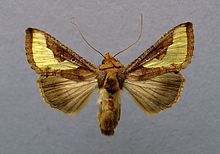| Slender burnished brass | |
|---|---|

| |
| Adult feeding on Salvia nectar | |

| |
| Mounted adult | |
| Scientific classification | |
| Domain: | Eukaryota |
| Kingdom: | Animalia |
| Phylum: | Arthropoda |
| Class: | Insecta |
| Order: | Lepidoptera |
| Superfamily: | Noctuoidea |
| Family: | Noctuidae |
| Genus: | Thysanoplusia |
| Species: | T. orichalcea |
| Binomial name | |
| Thysanoplusia orichalcea (Fabricius, 1775) | |
| Synonyms | |
| |
Thysanoplusia orichalcea, the slender burnished brass, is a moth of the family Noctuidae. The species was first described by Johan Christian Fabricius in 1775. It is a polyphagous pest of vegetable crops that originated in Indonesia, from where it spread to Europe, South Asia, India, Sri Lanka, Africa, Australia and New Zealand. In northern Europe it is a migrant species.
Description
For a key to the terms used, see Glossary of entomology terms.

The wingspan is 36–44 mm. Its head, collar and the vertex of its head are reddish orange. Tegulae and forewings pale reddish brown. The forewings are extensively covered with a metallic golden shimmering surface. Only the costal field and hem are brown. Sub-basal, antemedial and postmedial waved lines very indistinct, fine and whitish in colour. The sub-marginal line irregularly lunulate. The reniform and orbicular tain are small and white bordered. The unpatterned hindwings are grey brown, somewhat darker at the margin. The thorax is furry and with some hair tufts, the proboscis is well developed.
Larva bluish green with a few short dorsal hairs. There are slender dorsal white lines and a prominent lateral line.
Ecology
The moth flies from August to October, depending on the location.
The larvae feed on various herbaceous plants, including crops such as sunflower, Coreopsis, potato and soybean. In managing their population, phenylacetaldehyde, a volatile floral compound attractive to many Lepidoptera and present in Canada thistle (Cirsium arvense), was found to be effective in trapping especially the females of the species.
Gallery
-
 Strong golden wing iridescence as revealed in favourable illumination
Strong golden wing iridescence as revealed in favourable illumination
-
 Illuminated from a different angle
Illuminated from a different angle
-

-

References
- Plantwise Knowledge Bank
- ^ Stringer, L.D.; et al. (December 2008). "Floral attractants for the female soybean looper, Thysanoplusia orichalcea (Lepidoptera: Noctuidae)". Pest Management Science. 64 (12): 1218–21. doi:10.1002/ps.1621. PMID 18615789.
- Hampson, G. F. (1894). The Fauna of British India, Including Ceylon and Burma: Moths Volume II. Taylor and Francis – via Biodiversity Heritage Library.
- "Robinson, G. S., P. R. Ackery, I. J. Kitching, G. W. Beccaloni & L. M. Hernández, 2010. HOSTS – A Database of the World's Lepidopteran Hostplants. Natural History Museum, London".
External links
- "73.004 BF2433 Slender Burnished Brass Thysanoplusia orichalcea (Fabricius, 1775)". UKMoths. Retrieved January 23, 2019.
- Savela, Markku. "Thysanoplusia orichalcea (Fabricius, 1775)". Lepidoptera and Some Other Life Forms. Retrieved January 23, 2019.
- "09078 Thysanoplusia orichalcea (Fabricius, 1775) - Südliche Goldeule". Lepiforum e.V. Retrieved January 23, 2019.
| Taxon identifiers | |
|---|---|
| Thysanoplusia orichalcea |
|
This Plusiinae-related article is a stub. You can help Misplaced Pages by expanding it. |
- Plusiinae
- Moths described in 1775
- Agricultural pest insects
- Owlet moths of Africa
- Moths of Australia
- Moths of Cape Verde
- Moths of the Comoros
- Owlet moths of Europe
- Moths of Japan
- Moths of Madagascar
- Moths of Mauritius
- Moths of the Middle East
- Moths of New Zealand
- Moths of Réunion
- Moths of Asia
- Taxa named by Johan Christian Fabricius
- Plusiinae stubs